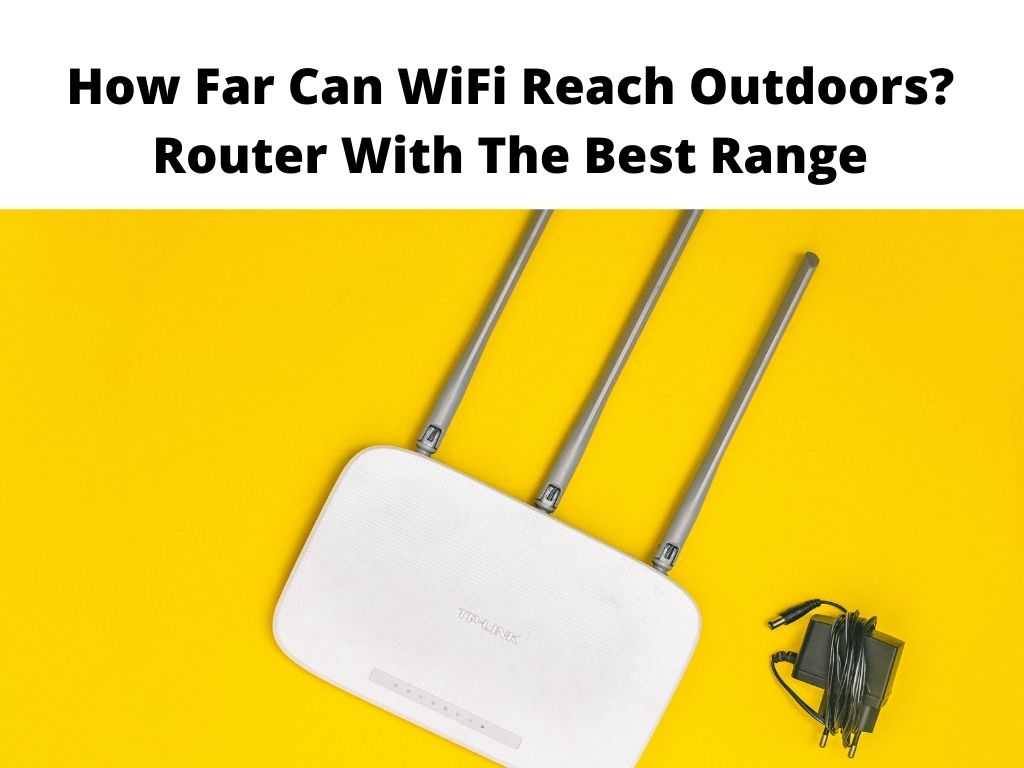How far can WiFi reach outdoors has been a reoccurring question by most of the subscribers. If you’re observant, you must have noticed that WiFi signals have its restriction.

The further the WiFi tends to go, the weaker it will become. It’s similar to a human voice. For instance, whenever you yell or speak, your voice will be loud to the person near but the same cannot be said as the voice travels far.
A WiFi’s range is dependent mainly on the access point number it was configured with.
For instance, a typical home network that has a single wireless router can be enough for a single-family dwelling but not as much as it ought to be.
For business networks with more than one access point, it can cover the entire building.
Wireless networks that can extend to more miles can now be seen in some cities. This has helped increase network range.
Table of Contents
Distance of WiFi outdoors
When it comes to a home network, a general rule states that a WiFi network on normal 2.4 GHz can reach up to 46 meters i.e., 150 feet indoors, and 92 meters i.e., 300 feet outdoors.
Older routers configured on 802.11a 5 GHz extend close to one-third of these distances. New model routers of 802.11n & 802.11ac on either 2.4 or 5 GHz bands vary.
Obstructions to Wi-Fi
Physical obstructions in our homes like metal frames, bricks, siding windows and doors, limit the range a WiFi network should reach by up to 25%.
As a result of the law of physics, 5GHz W-Fi is more vulnerable to obstruction;
- Radio signals that emanate equipment like oven, microwave, and other equipment can affect the range of the WiFi network. This is because WiFi with a 2.4 GHz ratio is used to manufacture consumer gadgets. Their disadvantage is that it is frequently affected by interference, especially within a house.
- The antenna orientation will depend on the distance a device can connect to it. Phone users will notice that their connection strength will either increase or decrease as the antenna is been turned to different angles. In addition, some might make use of directional antennas that guarantee a longer especially in the areas the antenna is directed to but a reduced reach in other areas.
- The category of the wireless router is another thing to consider. Routers that have higher power tend to cover more range. But you must note that the wireless connection that exists between the device and router is also reduced by the client’s radio. Hence, in a situation you make use of a mobile device or laptop with a lower power radio, the link won’t be that strong.
- Category of 802.11 protocol used. Here, once the data rate is higher, the distance covered will reduce. Also, when the signal bandwidth (20/40/80/160), is wide enough, the distance covered will also reduce. An 802.11b router supports the narrowest bandwidth and data rate. With this, it can offer a reasonable speed. However, the 802.11ac standard offers the highest but it must be within a short distance close to the router.
- The physical environment is another factor that varies. This is because the WiFi signal will need to pass through numerous materials which in turn, weakens the signal.
Router with the most extended range
The NETGEAR Nighthawk X10 is a device was manufactured to manage any power. The speed is up to 7,200 Mbps as it still maintains a maximum range of about 3000 sq ft.
It also comprises advanced tech such as adjustable antennas and beamforming for a signal extension.
WiFi 6 also does pretty well when it comes to a device connected to the internet. It has features like better battery consumption, enhanced security, lower latency, and increased range and efficiency.
The role of WiFi Extenders
If your house is big and you desire to communicate effectively with someone within a far room or maybe upstairs, then you need a home intercom which is a wired WiFi extender.
In a situation, your router is at a corner of the home and it’s difficult to access good performance, a WiFi extender is needed to reduce the path loss from the router location to the other end.
The good thing about extenders is that it makes use of existing ethernet cables or wiring in extending the network to other parts of the house.
In other words, they function by conveying the data via the ethernet cable, hence, reducing the path the WiFi has to travel. The outcome offers a more reliable WiFi signal.
In Conclusion
A WiFi device that comprises of 2.4 GHz band can extend the network to about 20-30Ft but the data transmission is slow.
For a WiFi device that functions on 5GHz, it offers less coverage but the data transmission is fast. Normally, the range is about 10-15ft. Just that its increased frequency still can’t penetrate solid objects.
Frequently Asked Questions
Is there a way I can extend WiFi to outdoor?
You can make use of a WiFi extender, booster, or repeater. Then it should be set up towards the outdoor you intend to reach. A window will be preferable to reduce interference from any object. Alternatively, you can make use of mesh units if you already have a mesh system in the house.
What’s the distance a WiFi can reach outdoors?
Usually, for 2.4 GHz WiFi, it’s 46meters i.e., 150 feet indoors, and 92 meters i.e., 300 feet outdoors.
Can WiFi go through a wall?
Yes, WiFi signals can penetrate walls or even other obstacles but it will depend on the thickness of the wall. For instance, reinforce concrete walls block WiFi signals.


